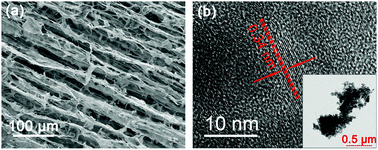Konjac glucomannan-derived nitrogen-containing layered microporous carbon for high-performance supercapacitors
Abstract
Biomass-derived carbon-based materials represent a promising class of candidates for supercapacitors. Herein, we developed a new route for the fabrication of biomimetic layered microporous carbon for high-performance supercapacitors by hybridizing konjac glucomannan (KGM) with cysteine (Cys) using a cost-efficient method. When the mass ratio of Cys/KGM was 1 : 6 and the carbonized temperature was 800 °C (denoted as Cys/KGM-800-6), Cys/KGM-800-6 retained the atomic ratio of 5.89% nitrogen atoms. Additionally, the proportion of micropores in Cys/KGM-800-6 reached 93.02% with an average micropore diameter of 2.16 nm. In the capacitance test, the specific capacitance of Cys/KGM-800-6 was 351.7 F g−1 and 226 F g−1 at the current densities of 1 A g−1 and 20 A g−1, respectively. After 10 000 charge–discharge cycles, the hybrid materials maintained 95.57% of the specific capacitance of the pristine material at the current density of 1 A g−1. This work demonstrates a potential synthetic method for boosting the performance of carbon-based supercapacitors through the hybridization of common natural biomass and amino acid.



 Please wait while we load your content...
Please wait while we load your content...